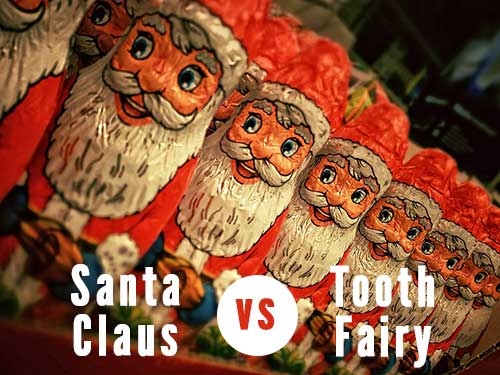As far as mythical childhood characters go, who wins the battle for being the most mystical and benevolent of them all? Santa Claus brings gifts to all the well-behaved children in the world on Christmas Eve but leaves the naughty ones a lump of coal. On the other hand, the Tooth Fairy will give a cash reward to any child who offers up their baby teeth without any regard for whether or not they “deserve” it. In terms of magical fantasy, you may be surprised to find out that the Tooth Fairy rivals Santa Claus in a number of ways.

The Tooth Fairy Outside of the United States
According to the Smithsonian Magazine, the legend of the Tooth Fairy is a “very recent, very American creation” that first appeared around the turn of the 20th century. However, in “every other recorded human culture” there is “some kind of tradition surrounding the disposal of a child’s lost baby teeth.” For example, take Ratoncito Pérez. Also known as Ratón Pérez, or “Pérez Mouse” in English, this mystical figure is popular in Spanish and Hispanic cultures who originated from Madrid in 1894.
Ratón Pérez is similar to the Tooth Fairy in that he will exchange a gift for a child’s tooth. When a child loses a tooth they place it under their pillow and just like the Tooth Fairy, this little mouse will swap it out for a small present (which is not always money). In Argentina, some children will put their tooth in a glass of water at their bedside for Pérez to drink up to quench his thirst, and after emptying the glass he will take the tooth!
In Navajo culture, the mother serves as the Tooth Fairy! She saves the baby tooth until the child’s mouth stops hurting, and then she takes it southeast from the home and buries the tooth on the east side of a healthy and young sagebrush, or rabbitbrush, or pinyon tree because the direction east is associated with childhood.
Some children in the world throw their teeth onto their roof instead of burying it under their pillow. In India, China, Korea, and Vietnam, children who lose their teeth from their lower jaw will toss the tooth onto the roof of their house, and teeth lost from the upper jaw will go into a space beneath the floor. Then, the child is supposed to shout out a request for the tooth to be replaced with the tooth of a mouse because mice grow their teeth for their entire lives (a characteristic of all rodents). In Japan, this tradition is slightly modified in that the lost upper teeth are thrown straight down to the ground and lower teeth are thrown straight into the air – both in the direction of where they want their new teeth to grow.
Who Wins, Santa Claus or the Tooth Fairy?
Children may be more excited about the arrival of Santa every year, but kids outgrow their presents and the Tooth Fairy, in whichever incarnation you believe in, brings the promise of permanent teeth that one can only hope will last a lifetime. The Tooth Fairy can arrive at any time of the year and will leave gifts in addition to new teeth whether or not the kids have made the appropriate list! Santa Claus often brings way too many sugary treats that are not good for children’s teeth, but the Tooth Fairy will encourage the new adult teeth to replace the lost baby teeth. In terms of dental hygiene and oral health, the Tooth Fairy wins this contest!
How do you celebrate the Tooth Fairy or your kids losing their baby teeth in your family? Do you have your own special familial tradition, or cultural tradition not represented here? At North Tonawanda Family Dentistry, we care about the oral health of your entire family. Schedule a family dentist appointment today!
